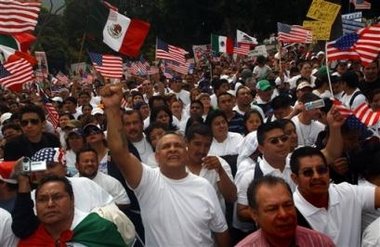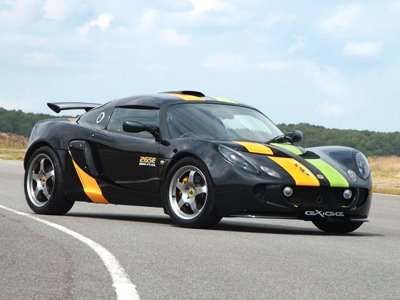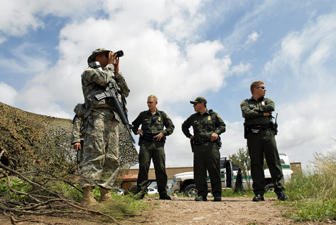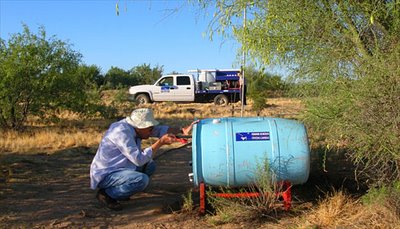 The protest march in downtown Los Angeles went from Broadway and Olympic to City Hall. Image Credit: Bob Chamberlin / LAT - Mar. 25, 2006
The protest march in downtown Los Angeles went from Broadway and Olympic to City Hall. Image Credit: Bob Chamberlin / LAT - Mar. 25, 2006Rally Redux – More Of A GOOD Thing!
The last time all of the illegal immigrants hit the streets to protest the actions our country planned to take to reform the current state of immigration chaos, the Congress finally approved 370 miles of new border fence and 500 miles of road barriers.
Further, due to the "day without immigrants" protests back in May, citizens that were once ambivalent about masses of people wanting to set up shop in our country without permission, aligned themselves with the rest of the 70% of us who wanted to protect the sovereignty of our country.
This from The Washington Post -
More Immigration Demonstrations Planned
D.C. Rally to Draw From East Coast
By Karin Brulliard - Washington Post Staff Writer - Thursday, August 31, 2006; Page A12
After four months of relative quiet, immigration reform advocates are mobilizing a new round of protests in Washington and other cities to put pressure on a returning Congress and reinvigorate a Latino movement that awakened in massive demonstrations this spring.
The events will begin tomorrow in Chicago, where demonstrators plan to set out on a four-day march to the district offices of House Speaker J. Dennis Hastert (R) in Batavia, Ill., and will continue with one-day rallies throughout next week in Phoenix, Washington and Los Angeles.
In the Washington region, activists are distributing leaflets, and Spanish-language radio is buzzing about a Sept. 7 rally that organizers hope will be the biggest yet. Organizers say their goal is 1 million protesters from up and down the East Coast for a rally on the Mall and a march to the White House.
"We want to make sure that Congress and this administration get a very clear message that the immigrant community is still paying attention to what's happening in the immigration debate and that we know that it's election time," said Jaime Contreras, chairman of the National Capital Immigration Coalition, the rally's organizer.
Local organizers said they are improving on spring rallies that were hastily planned amid a spontaneous groundswell of activism. To avoid a backlash against foreign flags, they are directing all protesters to carry U.S. flags. They are starting the rally at 4 p.m. so student demonstrators, who frustrated school administrators by walking out earlier this year, can participate. And organizers have nearly tripled their budget for portable toilets.
----
Some believe it could be risky. The spring protests roused supporters but also stirred fierce hostility, said Steven A. Camarota of the Center for Immigration Studies, which favors lower levels of immigration. That kind of intensity might make members of Congress, which is approaching midterm elections, even less likely to touch the immigration issue.
"They want to energize the community . . . to put the issue on the agenda and make it clear that look, it's not going away," Camarota said. "By doing all that, they may also hurt the prospect of the legislation passing."
----
But organizers say the movement has not lost steam. Immigrants, they said, are enthusiastic about the coming protests, believing the demonstrations empower them and weaken support for an enforcement-only House proposal.
----
Other observers are uncertain. Carlos Aragon, general manager of Radio Fiesta (1480 AM), a Woodbridge station that has been broadcasting information about the Sept. 7 rally, said the event is a hot topic among listeners -- but they now sound more cautious.
"Nothing happened in regard to immigration in Congress," Aragon said. "People are just not sure if it will help."
This week's Chicago march will be followed by protests Sept. 4 in Phoenix and Sept. 9 in Los Angeles.
Unlike previous rallies that drew people from the Washington region, the Sept. 7 event will include participants from along the East Coast. Organizers said at least 100 busloads of marchers will roll in.
To encourage local turnout, organizers are intensifying the strategies they used in the spring. They are playing radio promotional spots each hour on some Spanish-language stations. Volunteers are distributing fliers at churches, soccer fields, Metro stations and construction sites.
With the responsibility of having a demonstration for out-of-towners upon them, local leaders are striving to plan a smoother -- and savvier -- event.
On a recent night, organizer Edgar Rivera led a planning meeting at the Alexandria offices of Tenants and Workers United. He listed all that will be different about this march: After rallying, demonstrators will proceed to the White House for the first time, he said.
Organizers will dispatch Spanish-speaking volunteers to Metro stations to direct demonstrators, Rivera told those gathered. And more high-profile speakers will be included -- maybe Jesse L. Jackson and a Catholic cardinal, he said -- but fewer politicians.
"It's the community that should be out there," Rivera said.
Read All>>
THAT community can show up and protest in the streets all that they want. They can claim the southwest United States is part of AZTLAN, and that they have the same rights as those of us who ARE citizens.
The rally redux will be more of a good thing for the community of United States citizens.
The community that citizens belong to will just keep the pressure up on our ELECTED OFFICALS to increase the fence (maybe we should change the fence to a wall) and the road barriers along with the increase of fines levied on businesses that hire the undocumented, illegal alien. Then, maybe, the members of THAT community might go home or work to become members of the community of United States citizens.

























